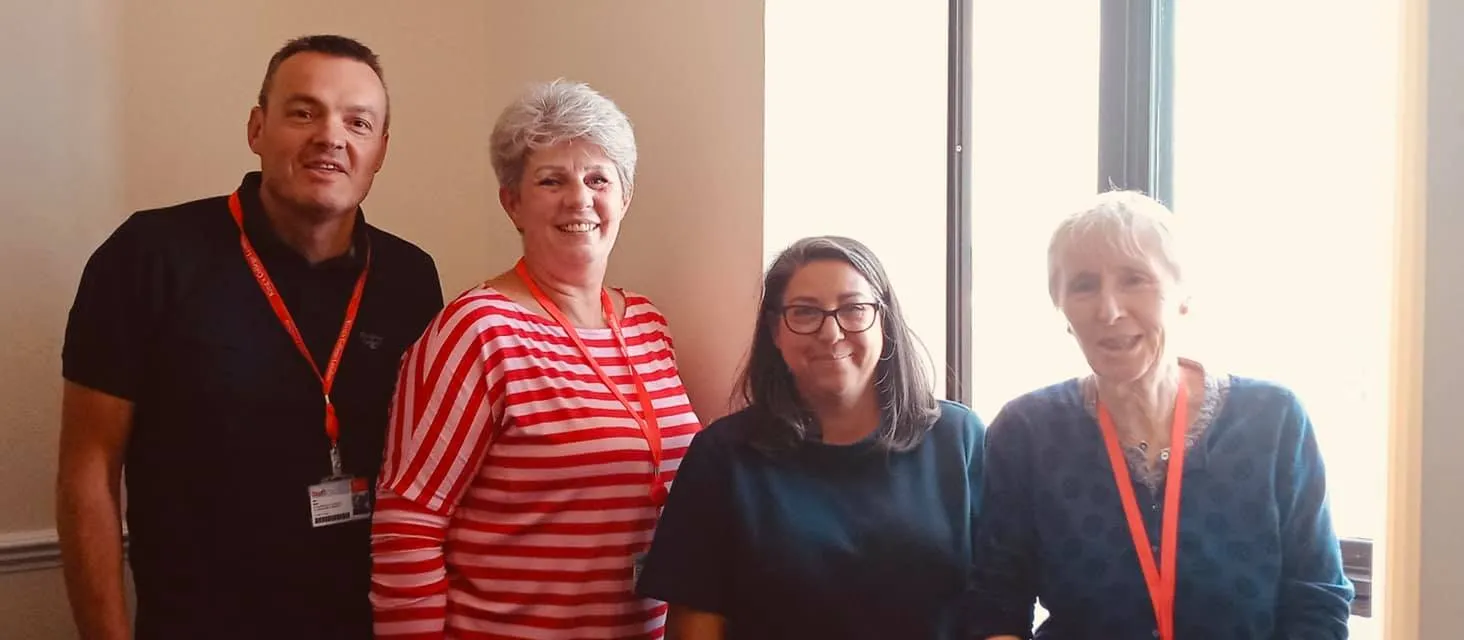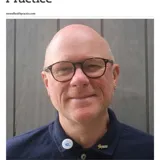Having been in at the initial development of what became Safewards, it has been fantastic to see how it has spread across the world to be used by mental health nurses and their colleagues to create calmer, safer mental health wards. The input of service users, carers and many staff in those early years has been justly rewarded.
Professor Alan Simpson
04 June 2024
When an adult with severe mental health problems can no longer be supported at home, they can be admitted to inpatient services such as a psychiatric hospital. In the last ten years the number of adults admitted annually to these facilities has risen.
In these already highly pressured and challenging environments instances of patient conflict behaviours (aggression, violence, self-harm, absconding, substance use) and staff containment behaviours (medication, physical restraint, seclusion, special observation) vary between psychiatric inpatient wards, with few explanations as to why. This is important as both conflict and containment – even if understandable – cause considerable physical and psychological harm to both staff and patients.
King’s researchers were interested in understanding the mechanics of conflict and containment in services and how best to minimise their use.
The need for a coherent model for dealing with conflict and containment
This work first started with Professor Len Bowers assembling researchers from King’s, the Royal College of Psychiatrists, London NHS (National Health Service) trusts, UCL and City, University of London, to explore the variations between conflict and containment on individual wards. In 2010, this developed into an extensive and comprehensive research programme, which initially looked at the practices in acute inpatient psychiatric care to establish aspects of conflict and containment.
King’s researchers carried out a series of systematic reviews that indicated several factors, such as managing the physical environment, or staff not explaining the ward structure to patients, were important contributors to increased conflict, alongside factors relating to the patients themselves. They also realised the patterns of conflict behaviour in patients corelated with the use of containment methods by staff. In other words, while patient conflict could lead to staff containment, it is also the case that staff use of containment can lead to patient conflict.
In response to those findings, a team led by Professor Bowers and Professor Alan Simpson developed and piloted a suite of interventions to address these issues. This team included expert inpatient staff service users and carers and was hugely assisted by the Service User (and Carer) Group Advising Research (SUGAR).

The Safewards Model
King’s Safewards Model highlights six factors that can lead to "flashpoints” - precursors or triggers for conflict and/or containment.
These six factors are: the staff team, the physical environment, factors outside hospital, the patient community, patient characteristics and the regulatory framework. The model hypothesised that wards that reduced and or managed flashpoints better had less conflict and containment.
From the model approximately 300 ideas for interventions to reduce or manage flashpoints, which had been identified in evidence reviews, were rated, and consolidated by King’s researchers. Service users, carers and expert professionals were consulted before selecting 16 potential interventions for pilot testing. Following the pilot, which showed promising results, the wards involved advised on the 10 interventions they felt were both practical and achievable within the average acute ward setting.
This dynamic model systematically showed how understanding its central principles can inform strategies that promote the safety of patients and staff, leading to a healthier work and recovery environment.
The benefits of Safewards
King’s researchers tested the now 10 Safewards interventions in a cluster randomised controlled trial (RCT) on 31 wards at 15 hospitals. It demonstrated that Safewards produced a 15% decrease in the rate of conflict and a 26% decrease in the rate of containment.
By lessening the incidents of both conflict and containment, Safewards benefits both staff and patients by making their ward safer for both groups.
Safewards is recommended by government and healthcare bodies
Safewards’ success was recognised in 2015 when it was recommended on the National Institute for Health and Care Excellence (NICE) Guideline NG10: ‘Violence and aggression. Short-term management in mental health, health, and community settings’. In this guideline Safewards was identified as one of only two conflict and containment management interventions with good evidence to recommend their use.
That same year the Department for Health recommended that all healthcare providers should consider the implications of the Safewards interventions in their own services.
Safewards was also recommended by NHS England and The National Institute for Health Research. Additionally, the Care Quality Commission repeatedly endorsed it as a “good initiative to embrace a culture of safety.”

Implementing Safewards across England and the UK
The Safewards website was launched in 2013 and it has made the model’s interventions freely and easily available to all, with no registration requirement. This was deliberately done to minimise barriers and maximise take-up. This means there is no clear number of how many trusts and teams have implemented Safewards. It is also clear that wards other that acute inpatient units were interested in the interventions.
However, King’s researchers are aware of implementation in many organisations across the UK including NHS Trusts such as South London & Maudsley, Greater Manchester Mental Health (GMMH), Sussex Partnership, Lincolnshire Partnership, West London, Worcestershire, Kent, Berkshire, Derby, Leicester, Oxleas, Merseycare, Sheffield, Midlands Partnership, Cumbria Northumberland and Tyne and Wear (CNTW), Tees, Esk and Wear Valleys (TEWS), as well as Fife and Boarders NHS Trust in Scotland, Health Boards in Wales and five Health and Social Care Trusts in Northern Ireland. Many independent providers in the UK have also implemented Safewards in their services.
One PICU unit in Sussex Partnership NHS Trust subsequently reported that they had recorded a 63% decrease in seclusion, 45% decrease in restraints, and a 53% decrease in use of rapid tranquilisation medication following Safewards implementation. In CNTW all wards within the Trust utilise Safewards as part of a Trust led Positive & Safe Strategy called Talk 1st. In its second year, Talk 1st reported that restraint was down 23%, seclusion down 21% and staff assault reduced by 18% across the Trust.
We are very grateful for being included in this project. It has made a huge difference to our ward and has made us a more cohesive team. We have noticed a great reduction in incidents and a huge increase in the use of Talk Down Methods and the [comfort/self-soothe] box. We will continue to use the 10 interventions as it has made our young people happy!
Staff member at CYP Safewards project celebration day
Implementing Safewards internationally
In the state of Victoria, Australia, $2.4 million was invested in Safewards implementation, initially in 58 mental health units, with a second phase that included emergency departments and acute medical units.
Also in Australia, a replication of the Bowers study in one large metropolitan local health district in New South Wales led by Dr Geoffrey Dickens resulted in reductions of Conflict and Containment of 23.0% and 12.0%, respectively. Following the Victoria investment, Safewards has been taken up across Australia in a variety of both mental health and general healthcare.
Alongside experts-by-experience and funded by New South Wales Nursing and Midwifery Office, our research team worked with clinical nurses and other staff on seven wards in South Western Sydney including a PICU and an adolescent mental health unit. The rates of patient conflict and staff containment behaviours reduced, and this was sustained after researcher support was withdrawn. The study provided further evidence to support Safewards, while also demonstrating that it has the potential to have positive effects outside the context of an extensively resourced randomised controlled trial.
Dr Geoffrey Dickens, Northumbria University
In Denmark, Safewards has been implemented in around half of all mental health units (including the Faroe Isles), reducing forced sedation and mechanical restraints.
We Danes have been particularly impressed with two Safewards interventions, “calm down methods” where staff offer patients non-medical self-soothing items when they are struggling and the "Discharge Messages” where patients who are going home leave messages of hope and support for new patients. We see these Discharge Message trees in many variations across our services. In the region Zealand part of Denmark, where I work, we analyse conflict and containment episodes through the Safewards six domains. So Safewards is a new language, and a new way of looking at and understanding our services that is not only used by nurses, but all professions.
Professor Lene Lauge Berring, University of Southern Denmark

Additionally, Safewards has been implemented in Canada, Holland, Germany, Austria, Switzerland, Sweden, Norway, Finland, Malta, Ireland, The Czech Republic, Slovakia, and Spain. In Germany, Austria and Switzerland, a network of Safewards implementors has driven the uptake across multiple services. This has also been the case in Sweden and the Czech Republic.
In Tasmania, Finland, and Belgium Safewards interventions are either recommended or are being actively implemented in hospitals to drive quality improvements in mental health inpatient care. In 2019 the Ministry of Health of the Republic of Indonesia sent a team of doctors and nurses to the UK to learn about Safewards for use in their services.
Many of these international colleagues have contributed to the Safewards website material being translated into German, Turkish, Dutch, Finnish, Danish, Polish, Czech, and Spanish, with thousands of international visitors to website every year. In 2023, the British Council provided funding for the material to be translated into Chinese as part of a bigger implementation project.
The future for Safewards?
Safewards has been taken up across a range of services in multiple countries. However, in doing so, is has also moved from its original context – acute inpatient mental healthcare.
A recent project commissioned by NHS England to explore the possible use of Safewards in Children and Young People’s (CYP) Mental Health services demonstrated that the interventions were both acceptable and adaptable. Work co-ordinated by Dr Tessa Maguire and team in Australia has shown comparable results in Forensic and Secure Mental Health Services.
Safewards is now being used in other health contexts – both mental health and general health settings, and there is a growing need for further research to explore if the use of Safewards produces similar outcomes, in terms of reduction of conflict and containment, as seen in acute inpatient mental health.
There is also a need to gather more evidence on the experience and use of Safewards from the patient perspective. While there are a few quality critiques from Canada and Australia as well as adaptions co-designed with the Māori community in New Zealand, there remains much to learn from experts by experience and carer communities.
The Safewards journey is now ten years running and counting. While there is much to celebrate in these ten years, there are also questions and challenges that should occupy our thinking for the years to come. Finally, while Safewards indicates that we can actively reduce both conflict and containment, there remains an open question as to what more we can achieve and how best to do this.
Without the commitment and work of both staff and patients in ward communities, Safewards is just another research study, albeit a good one. For me, Safewards has become a template, a song sheet of improvement if you will. Ward communities, up and down the country and across the world, now use Safewards to sing their own, individual version to suit their own, individual needs. I’m looking forward to the future where Safewards finds new voices who want to sing it and listening to the songs that they sing.
Geoff Brennan
For information on the model and interventions, go to www.safewards.net.


